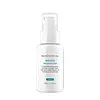What's inside
What's inside
 Key Ingredients
Key Ingredients

 Benefits
Benefits

 Concerns
Concerns

No concerns
 Ingredients Side-by-side
Ingredients Side-by-side

Water
Skin ConditioningSqualane
EmollientGlycerin
HumectantIsopropyl Lauroyl Sarcosinate
Skin ConditioningUndecane
EmollientButyrospermum Parkii Butter
Skin ConditioningTridecane
PerfumingPEG-100 Stearate
Glyceryl Stearate
EmollientPEG-20 Stearate
EmulsifyingAmmonium Polyacryloyldimethyl Taurate
Emulsion StabilisingBisabolol
MaskingButylene Glycol
HumectantCaffeine
Skin ConditioningCaprylyl Glycol
EmollientCarbomer
Emulsion StabilisingCetyl Alcohol
EmollientDextrin
AbsorbentDisodium EDTA
Eperua Falcata Bark Extract
Skin ProtectingFarnesol
PerfumingPalmitoyl Tripeptide-8
Skin ConditioningPanthenol
Skin ConditioningPentaerythrityl Tetra-Di-T-Butyl Hydroxyhydrocinnamate
AntioxidantSodium Benzoate
MaskingTocopherol
AntioxidantTriethanolamine
BufferingXanthan Gum
EmulsifyingZinc Gluconate
Skin ConditioningWater, Squalane, Glycerin, Isopropyl Lauroyl Sarcosinate, Undecane, Butyrospermum Parkii Butter, Tridecane, PEG-100 Stearate, Glyceryl Stearate, PEG-20 Stearate, Ammonium Polyacryloyldimethyl Taurate, Bisabolol, Butylene Glycol, Caffeine, Caprylyl Glycol, Carbomer, Cetyl Alcohol, Dextrin, Disodium EDTA, Eperua Falcata Bark Extract, Farnesol, Palmitoyl Tripeptide-8, Panthenol, Pentaerythrityl Tetra-Di-T-Butyl Hydroxyhydrocinnamate, Sodium Benzoate, Tocopherol, Triethanolamine, Xanthan Gum, Zinc Gluconate
Water
Skin ConditioningMethylpropanediol
SolventGlycerin
Humectant1,2-Hexanediol
Skin ConditioningPolyglycerin-3
HumectantCaprylic/Capric Triglyceride
MaskingBetula Platyphylla Japonica Juice
Skin ConditioningSodium Hyaluronate
HumectantGlyceryl Glucoside
HumectantHydrolyzed Hyaluronic Acid
HumectantButylene Glycol
HumectantHyaluronic Acid
HumectantAscorbic Acid
AntioxidantBeta-Glucan
Skin ConditioningDipotassium Glycyrrhizate
HumectantHydrogenated Lecithin
EmulsifyingEthylhexylglycerin
Skin ConditioningEclipta Prostrata Leaf Extract
Skin ConditioningLaminaria Japonica Extract
Skin ProtectingAvena Sativa Kernel Extract
AbrasiveCynara Scolymus Leaf Extract
Skin ConditioningPteris Multifida Extract
AntioxidantMelia Azadirachta Leaf Extract
Skin ConditioningMelia Azadirachta Flower Extract
Skin ConditioningCoccinia Indica Fruit Extract
Skin ConditioningAloe Barbadensis Flower Extract
EmollientSolanum Melongena Fruit Extract
Skin ConditioningOcimum Sanctum Leaf Extract
Skin ConditioningCorallina Officinalis Extract
Skin ConditioningCurcuma Longa Root Extract
MaskingCyclohexasiloxane
EmollientDipropylene Glycol
HumectantAmmonium Acryloyldimethyltaurate/Vp Copolymer
Xanthan Gum
EmulsifyingFructooligosaccharides
HumectantCarbomer
Emulsion StabilisingDisodium EDTA
Polyquaternium-51
Skin ConditioningTromethamine
BufferingTocopherol
AntioxidantWater, Methylpropanediol, Glycerin, 1,2-Hexanediol, Polyglycerin-3, Caprylic/Capric Triglyceride, Betula Platyphylla Japonica Juice, Sodium Hyaluronate, Glyceryl Glucoside, Hydrolyzed Hyaluronic Acid, Butylene Glycol, Hyaluronic Acid, Ascorbic Acid, Beta-Glucan, Dipotassium Glycyrrhizate, Hydrogenated Lecithin, Ethylhexylglycerin, Eclipta Prostrata Leaf Extract, Laminaria Japonica Extract, Avena Sativa Kernel Extract, Cynara Scolymus Leaf Extract, Pteris Multifida Extract, Melia Azadirachta Leaf Extract, Melia Azadirachta Flower Extract, Coccinia Indica Fruit Extract, Aloe Barbadensis Flower Extract, Solanum Melongena Fruit Extract, Ocimum Sanctum Leaf Extract, Corallina Officinalis Extract, Curcuma Longa Root Extract, Cyclohexasiloxane, Dipropylene Glycol, Ammonium Acryloyldimethyltaurate/Vp Copolymer, Xanthan Gum, Fructooligosaccharides, Carbomer, Disodium EDTA, Polyquaternium-51, Tromethamine, Tocopherol
 Reviews
Reviews

Ingredients Explained
These ingredients are found in both products.
Ingredients higher up in an ingredient list are typically present in a larger amount.
Butylene Glycol (or BG) is used within cosmetic products for a few different reasons:
Overall, Butylene Glycol is a safe and well-rounded ingredient that works well with other ingredients.
Though this ingredient works well with most skin types, some people with sensitive skin may experience a reaction such as allergic rashes, closed comedones, or itchiness.
Learn more about Butylene GlycolCarbomer is a polymer of acrylic acid. Its main role is to create a gel consistency.
A high amount of carbomer can cause pilling or balling up of products. Don't worry, most products contain 1% or less of carbomer.
Disodium EDTA plays a role in making products more stable by aiding other preservatives.
It is a chelating agent, meaning it neutralizes metal ions that may be found in a product.
Disodium EDTA is a salt of edetic acid and is found to be safe in cosmetic ingredients.
Learn more about Disodium EDTAGlycerin is already naturally found in your skin. It helps moisturize and protect your skin.
A study from 2016 found glycerin to be more effective as a humectant than AHAs and hyaluronic acid.
As a humectant, it helps the skin stay hydrated by pulling moisture to your skin. The low molecular weight of glycerin allows it to pull moisture into the deeper layers of your skin.
Hydrated skin improves your skin barrier; Your skin barrier helps protect against irritants and bacteria.
Glycerin has also been found to have antimicrobial and antiviral properties. Due to these properties, glycerin is often used in wound and burn treatments.
In cosmetics, glycerin is usually derived from plants such as soybean or palm. However, it can also be sourced from animals, such as tallow or animal fat.
This ingredient is organic, colorless, odorless, and non-toxic.
Glycerin is the name for this ingredient in American English. British English uses Glycerol/Glycerine.
Learn more about GlycerinTocopherol (also known as Vitamin E) is a common antioxidant used to help protect the skin from free-radicals and strengthen the skin barrier. It's also fat soluble - this means our skin is great at absorbing it.
Vitamin E also helps keep your natural skin lipids healthy. Your lipid skin barrier naturally consists of lipids, ceramides, and fatty acids. Vitamin E offers extra protection for your skin’s lipid barrier, keeping your skin healthy and nourished.
Another benefit is a bit of UV protection. Vitamin E helps reduce the damage caused by UVB rays. (It should not replace your sunscreen). Combining it with Vitamin C can decrease sunburned cells and hyperpigmentation after UV exposure.
You might have noticed Vitamin E + C often paired together. This is because it is great at stabilizing Vitamin C. Using the two together helps increase the effectiveness of both ingredients.
There are often claims that Vitamin E can reduce/prevent scarring, but these claims haven't been confirmed by scientific research.
Learn more about TocopherolWater. It's the most common cosmetic ingredient of all. You'll usually see it at the top of ingredient lists, meaning that it makes up the largest part of the product.
So why is it so popular? Water most often acts as a solvent - this means that it helps dissolve other ingredients into the formulation.
You'll also recognize water as that liquid we all need to stay alive. If you see this, drink a glass of water. Stay hydrated!
Learn more about WaterXanthan gum is used as a stabilizer and thickener within cosmetic products. It helps give products a sticky, thick feeling - preventing them from being too runny.
On the technical side of things, xanthan gum is a polysaccharide - a combination consisting of multiple sugar molecules bonded together.
Xanthan gum is a pretty common and great ingredient. It is a natural, non-toxic, non-irritating ingredient that is also commonly used in food products.
Learn more about Xanthan Gum